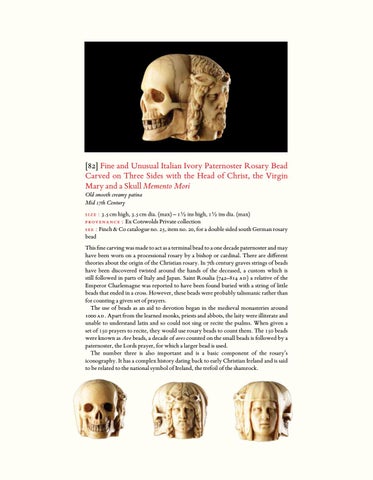[82] Fine and Unusual Italian Ivory Paternoster Rosary Bead Carved on Three Sides with the Head of Christ, the Virgin Mary and a Skull Memento Mori Old smooth creamy patina Mid 17th Century
s i z e : 3.5 cm high, 3.5 cm dia. (max) – 1½ ins high, 1½ ins dia. (max) p rov e na nc e : Ex Cotswolds Private collection s e e : Finch & Co catalogue no. 25, item no. 20, for a double sided south German rosary bead This fine carving was made to act as a terminal bead to a one decade paternoster and may have been worn on a processional rosary by a bishop or cardinal. There are different theories about the origin of the Christian rosary. In 7th century graves strings of beads have been discovered twisted around the hands of the deceased, a custom which is still followed in parts of Italy and Japan. Saint Rosalia (742–814 ad) a relative of the Emperor Charlemagne was reported to have been found buried with a string of little beads that ended in a cross. However, these beads were probably talismanic rather than for counting a given set of prayers. The use of beads as an aid to devotion began in the medieval monasteries around 1000 ad. Apart from the learned monks, priests and abbots, the laity were illiterate and unable to understand latin and so could not sing or recite the psalms. When given a set of 150 prayers to recite, they would use rosary beads to count them. The 150 beads were known as Ave beads, a decade of aves counted on the small beads is followed by a paternoster, the Lords prayer, for which a larger bead is used. The number three is also important and is a basic component of the rosary’s iconography. It has a complex history dating back to early Christian Ireland and is said to be related to the national symbol of Ireland, the trefoil of the shamrock.
